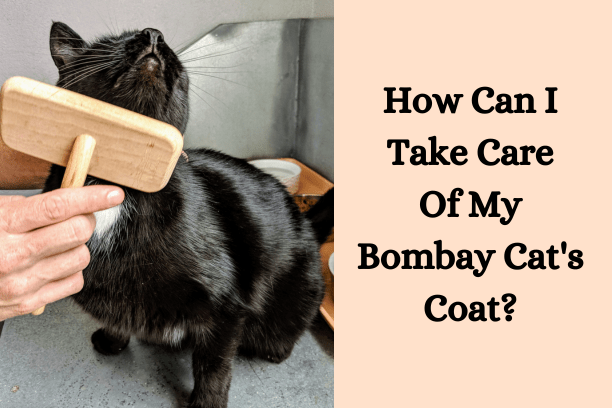Have you ever seen a cat that looks like a miniature black panther? If you have, chances are you have encountered a Bombay cat, one of the most exotic and rare cat breeds in the world. In this article, you will learn everything about How rare are Bombay cats? and it’s a stunning breed.
you need to know about its origin and history its appearance and personality, to its rarity and availability. Whether you are a cat lover, a potential adopter, or just curious, this piece of knowledge will give you valuable insights and tips on how to appreciate and care for these amazing felines.
Contents
- 1 How Bombay Cats Were Developed
- 2 How do you know if your cat is a Bombay?
- 3 What Bombay Cats Look Like and How They Behave
- 4 Why Bombay Cats Are Rare and How to Find One
- 5 Bombay Cat Price: How Much Do They Cost
- 6 What are some common health problems of Bombay cats?
- 7 How can I take care of my Bombay cat’s coat?
- 8 Conclusion
- 9 FAQs About How rare are Bombay cats?
How Bombay Cats Were Developed
The Bombay cat breed was created by Nikki Horner, a breeder from Louisville, Kentucky, in 1958. She had a vision of creating a cat that resembled a black panther, with a glossy black coat, a muscular body, and large golden eyes. To achieve this, she crossed sable American Burmese cats with black American Shorthair cats, and after several generations of selective breeding, she finally produced the first Bombay cat.
Horner’s breeding program was not easy, as she faced many challenges and setbacks along the way. She had to deal with genetic issues, such as the recessive black coat gene, the low fertility rate, and the health problems of the Burmese breed.
She also had to compete with other breeders who had similar goals and convince the cat associations to accept her new breed. Despite these difficulties, Horner persevered and succeeded in creating a cat that had the look and personality of a miniature black panther.
The Bombay cat breed was officially recognized and registered by the Cat Fanciers Association (CFA) in 1970, and by The International Cat Association (TICA) in 1979. Since then, the breed has gained popularity and recognition among cat enthusiasts and judges and has won many awards and titles.
How do you know if your cat is a Bombay?
Some distinctive features can help you identify a Bombay cat, such as its glossy black coat, its muscular build, its round head, its large copper-golden eyes, and its medium size.
However, the only way to be sure is to check the pedigree and registration papers of your cat, as other breeds can have similar traits, such as the British Bombay, the Burmese, or the American Shorthair.
What is special about Bombay cats?
Bombay cats are special because they have a unique combination of physical and personality traits that make them stand out among other cat breeds. They have a striking appearance that resembles a black panther, with a glossy black coat that reflects light and a muscular body that shows strength and agility.
They also have a charming personality that is affectionate, friendly, needy, playful, intelligent, and vocal. They love to be around people and other animals, and they crave attention and companionship.
They are also very curious and adventurous, and they enjoy exploring and learning new things. They are not shy, and they will let you know what they want and need with their expressive eyes and vocal sounds.
What Bombay Cats Look Like and How They Behave
Bombay cats have a stunning physical appearance that draws attention and admiration from anyone who sees them. They have a glossy black coat that shines like patent leather, and that feels smooth and silky to the touch.
Their coat is short and close-lying and does not require much grooming, except for occasional brushing and wiping. Their coat color is uniform and solid, without any markings or patterns, and it can range from jet black to brownish black, depending on the lighting and the season.

Bombay cats have a muscular build that shows their strength and agility. They are medium-sized cats, with males weighing between 8 and 15 pounds, and females weighing between 6 and 12 pounds.
They have a round head that is well-proportioned to their body, with a short and broad nose, a strong chin, and prominent cheekbones. They have large and round eyes that are set wide apart, and that have a captivating copper-golden color.
Their eyes can also have shades of green or orange, depending on the individual cat. They have medium-sized ears that are slightly tilted forward, and that have rounded tips. They have a long and graceful neck that leads to a broad chest and a sturdy back.
They have long and slender legs that are in proportion to their body, and that end with round and compact paws. They have a medium-length tail that is straight and tapered, and that is carried low.
Bombay cats have a delightful personality that is affectionate, friendly, needy, playful, intelligent, and vocal. They are very friendly and outgoing, and they love to be around people and other animals. They are not independent or aloof, and they crave attention and companionship.
They will follow you around the house, sit on your lap, sleep on your bed, and join you in whatever you are doing. They are also very loyal and devoted, and they bond strongly with their owners and family members. They are not aggressive or territorial, and they will get along well with other cats, dogs, and children, as long as they are introduced properly and treated kindly.
Bombay cats are very playful and energetic, and they enjoy a variety of toys and games. They are very curious and adventurous, and they like to explore and learn new things. They are also very intelligent and trainable, and they can learn tricks, commands, and even fetch.
They are not lazy or couch potatoes, and they need regular exercise and stimulation to keep them happy and healthy. They are also very vocal and expressive, and they will communicate with you with their distinctive sounds, such as chirps, purrs, and meows. They will let you know what they want and need, and they will also respond to your voice and name.
To keep your Bombay cat looking and feeling good, you need to provide some basic care and attention. Bombay cats do not require much grooming, as their coat is short and easy to maintain.
However, you should brush their coat once a week to remove loose hair and dirt, and to distribute natural oils. You should also wipe their eyes and ears with a damp cloth to prevent infections and irritations. You should trim their nails regularly to prevent scratching and injuries, and you should check their teeth and gums for signs of dental problems.
You should also bathe your Bombay cat occasionally, using mild shampoo and warm water, and dry them thoroughly afterward. Bombay cats need a balanced and nutritious diet to support their growth and health. You should feed them high-quality cat food that is appropriate for their age, size, and activity level, and that meets their nutritional needs.
You should avoid giving them human food, as some ingredients can be harmful or toxic to them. You should also provide them with fresh water at all times, and avoid giving them milk, as it can cause digestive problems. You should also monitor their weight and appetite, and consult your vet if you notice any changes or issues.
Bombay cats are generally healthy and robust, and they have a lifespan of 12 to 16 years. However, they can be prone to some health problems, such as respiratory infections, eye infections, skin allergies, and heart disease. Some of these problems are inherited from their parent breeds, while others are caused by environmental factors or poor care.
To prevent or treat these problems, you should take your Bombay cat to the vet regularly for check-ups, vaccinations, and treatments. You should also spay or neuter your Bombay cat to prevent unwanted pregnancies and reduce the risk of certain cancers. You should also keep your Bombay cat indoors, or provide them with a safe and enclosed outdoor space, to protect them from predators, diseases, and accidents.
Are all black cats in Bombay?
No, not all black cats are Bombay. Other cat breeds can have black coats, such as the British Bombay, the Burmese, the American Shorthair, the Oriental, the Maine Coon, and the Persian. However, these breeds have different physical and personality traits than Bombay, and they can be distinguished by their pedigree and registration papers.
Suggested: Cats With Big Noses
Why Bombay Cats Are Rare and How to Find One
Bombay cats are rare because they are not easy to breed and there are not many certified breeders in the US. Bombay cats are a cross between a black American Shorthair and a sable Burmese, and they require both parents to carry and pass on the recessive black coat gene to produce a black kitten.
This means that not all kittens from a Bombay cat litter will be black, and some may have different coat colors, such as sable, blue, or lilac. Bombay cats also have a lower fertility rate than other cat breeds, and they face some genetic issues, such as respiratory infections, eye infections, skin allergies, and heart disease.
These factors limit the availability and accessibility of Bombay cats and make them one of the most exotic and rare cat breeds in the world. First of all, you need to know How rare are Bombay cats? To find a Bombay cat, you will need to do some research and be patient.
You can start by looking for reputable Bombay cat breeders, rescue groups, or shelters, and contact them to see if they have any available kittens or cats. You can also check online directories, such as the Cat Fanciers Association (CFA) or The International Cat Association (TICA), to find registered Bombay cat breeders near you.
However, you should be prepared to be put on a waiting list, as Bombay cats are in high demand and there are not many of them. You should also be careful when choosing a breeder, and ensure they are ethical, responsible, and trustworthy. You should ask for a tour of the facilities, check the health and pedigree records of the cats, and avoid any breeder who offers you a cheap or quick deal.
If you cannot find a Bombay cat, or you want to consider other options, you can also look for some alternatives or similar breeds to Bombay cats, such as the British Bombay, the Burmese, or the American Shorthair.
These breeds have some physical and personality traits that are similar to the Bombay cat, but they may have different coat colors, sizes, or health issues. You can also look for other black cat breeds, such as the Oriental, the Maine Coon, or the Persian, but they will not have the same panther-like appearance or golden eyes as the Bombay cat.

Bombay Cat Price: How Much Do They Cost
Bombay cats are a popular breed of cats that resemble miniature panthers. They are known for their sleek black coat, copper eyes, and friendly personality. If you are interested in owning a Bombay cat, you may wonder how much they cost and what factors affect their price.
Purchase Cost
The purchase cost of a Bombay cat depends on whether you adopt or buy one from a breeder. Adopting a Bombay cat from a shelter or a rescue group is usually cheaper than buying one from a breeder, and you also help save a life. The adoption fee for a Bombay cat can range from $15 to $200, depending on the age, health, and location of the cat.
Some shelters and rescue groups may also include spaying or neutering, vaccinations, microchipping, and other services in the adoption fee. Buying a Bombay cat from a reputable breeder can be more expensive, but you may have more options in terms of the cat’s appearance, temperament, and pedigree.
The price of a Bombay kitten from a breeder can vary from $500 to $2,000, depending on the quality, bloodline, and demand of the cat. Show-quality Bombay cats with a purebred lineage and certification may cost more than pet-quality Bombay cats with mixed ancestry or no papers. You should also check the breeder’s reputation, health guarantee, and socialization practices before buying a Bombay cat from them.
Other Costs
Besides the purchase cost, there are other costs involved in owning a Bombay cat. These include
- Food: Bombay cats are active and muscular, and they need a high-quality diet to maintain their health and energy. You should feed your Bombay cat a balanced and complete cat food that meets their nutritional needs. The cost of cat food can vary depending on the brand, type, and quantity. On average, you can expect to spend around $20 to $40 per month on cat food for a Bombay cat.
- Litter and litter box: Bombay cats are fastidious and need a clean and comfortable litter box to do their business. You should provide your Bombay cat with a large and sturdy litter box that can accommodate their size and weight. You should also use clumping and unscented litter that is easy to scoop and dispose of. The cost of litter and litter boxes can range from $10 to $30 per month, depending on the quality and frequency of use.
- Toys and scratching posts: Bombay cats are playful and intelligent, and they need toys and scratching posts to keep them entertained and stimulated. You should provide your Bombay cat with a variety of toys that appeal to their instincts, such as balls, mice, feathers, and puzzles. You should also provide them with scratching posts that allow them to sharpen their claws and stretch their muscles. The cost of toys and scratching posts can vary depending on the quality and durability. On average, you can expect to spend around $10 to $20 per month on toys and scratching posts for a Bombay cat.
- Grooming: Bombay cats have short and glossy coats that do not require much grooming. However, you should still brush your Bombay cat once or twice a week to remove loose hair and dirt, and to distribute natural oils. You should also trim their nails, clean their ears, and brush their teeth regularly to prevent health problems. The cost of grooming can vary depending on the products and services you use. On average, you can expect to spend around $5 to $10 per month on grooming for a Bombay cat.
- Veterinary care: Bombay cats are generally healthy and robust, but they may still suffer from some health issues, such as respiratory problems, dental problems, and hypertrophic cardiomyopathy. You should take your Bombay cat to the vet at least once a year for a routine check-up, vaccinations, deworming, and flea and tick prevention. You should also spay or neuter your Bombay cat if they are not already, as this can prevent unwanted pregnancies, the Bombay cat’s behavioral problems, and some cancers. The cost of veterinary care can vary depending on the location, clinic, and services. On average, you can expect to spend around $100 to $200 per year on veterinary care for a Bombay cat.
- Pet insurance: Pet insurance is an optional but recommended expense for Bombay cat owners. Pet insurance can help cover the cost of unexpected accidents, illnesses, surgeries, and treatments for your Bombay cat. Pet insurance can also provide peace of mind and financial security in case of a medical emergency. The cost of pet insurance can vary depending on the provider, plan, and coverage. On average, you can expect to pay around $20 to $40 per month for pet insurance for a Bombay cat.
What are some common health problems of Bombay cats?
Bombay cats are a relatively healthy breed, but they can be prone to some health problems, especially those inherited from their parent breeds, the Burmese and the American Shorthair. Here are some common health problems of Bombay cats, based on some web search results:
Craniofacial Defect
- This is a genetic condition that affects the skull and facial structure of some kittens, especially those that have more Burmese traits.
- It is often fatal, as the kittens can have deformed skulls, absent ears, or brain protrusion.
- It is caused by a recessive gene that requires both parents to carry and pass on to produce a black kitten.
- It can be prevented by breeding only Burmese cats that are not carriers of the gene, and by checking the pedigree and health records of the cats.
Hypertrophic Cardiomyopathy
- This is a heart disease that causes the walls of the ventricle to thicken, reducing the efficiency of blood pumping.
- It can lead to congestive heart failure, which can cause labored breathing, lethargy, and sudden death.
- It has no direct treatment, but the symptoms can be managed by medications, diet, and regular check-ups.
- It can be inherited or acquired, and it is more common in male and older cats.
Aortic Thromboembolism
- This is a complication of hypertrophic cardiomyopathy, where a blood clot forms in the left atrium and travels to the aorta, blocking the blood flow to the rear limbs.
- It can cause sudden pain or paralysis in the hind legs, pale or bluish nail beds and paw pads, and irregular heartbeat.
- It is a medical emergency that requires immediate veterinary attention, as it can be life-threatening.
- It can be treated by medications, surgery, or amputation, depending on the severity and location of the clot.
Obesity
- This is a condition where the cat is overweight or has excess body fat, which can affect its health and quality of life.
- It can increase the risk of diabetes, arthritis, urinary tract infections, and liver disease.
- It can be caused by overfeeding, lack of exercise, or hormonal imbalance.
- It can be prevented and treated by feeding a balanced and portion-controlled diet, providing regular exercise and stimulation, and monitoring the weight and appetite of the cat.
Hypokalemia
- This is a condition where the cat has low levels of potassium in the blood, which can affect its muscle function and nerve transmission.
- It can cause weakness, lethargy, poor appetite, and muscle twitching or spasms.
- It can be caused by chronic kidney disease, urinary tract infections, or certain medications.
How can I take care of my Bombay cat’s coat?
Bombay cats have a sleek and shiny black coat that is easy to groom and maintain. However, they still need some basic care and attention to keep their coat healthy and beautiful. Here are some tips on how to take care of your Bombay cat’s coat, based on some web search results:
Brush your Bombay cat’s coat regularly
- Bombay cats have short and fine coats that do not shed much or mat easily. However, they still benefit from regular brushing to remove loose hair, dirt, and debris, and to distribute natural oils.
- You can brush your Bombay cat’s coat once a week or as needed, using a curry brush, a soft bristle brush, or a chamois cloth. Brush gently along the direction of the hair growth, and cover all parts of the body, including the chest and belly.
- Brushing your Bombay cat’s coat will also help you check for any skin problems, such as fleas, ticks, wounds, or allergies, and bond with your cat.
Bathe your Bombay cat’s coat occasionally
- Bombay cats are very clean and do not need frequent baths. However, you may need to bathe your Bombay cat’s coat occasionally, especially if it gets dirty or oily, or if it has a skin condition that requires medicated shampoo.
- To bathe your Bombay cat’s coat, use mild cat shampoo and warm water, and avoid getting water or soap in the eyes, ears, nose, or mouth. Massage the shampoo gently into the coat, and rinse thoroughly. Dry your cat with a towel or a hair dryer on a low setting, and keep your cat warm until completely dry.
- Bathing your Bombay cat’s coat will help you remove any dirt, grease, or odor, and keep the coat shiny and soft.
Protect your Bombay cat’s coat from the sun
- Bombay cats have a black coat that can absorb heat and make them prone to sunburn and overheating. Therefore, you should protect your Bombay cat’s coat from the sun, especially in the summer or in hot climates.
- You can protect your Bombay cat’s coat from the sun by keeping your cat indoors during the hottest hours of the day, providing shade and cool water if your cat goes outside, and applying a cat-safe sunscreen to the ears, nose, and other exposed areas.
- Protecting your Bombay cat’s coat from the sun will help you prevent sun damage, skin cancer, and heat stroke.

Conclusion
It’s an important question asked by cat owners How rare are Bombay cats? Bombay cats are one of the most exotic and rare cat breeds in the world, with a stunning appearance and a charming personality that resembles a miniature black panther.
In this article, you learned about how rare are Bombay cats. and how this breed was developed by Nikki Horner, a breeder from Louisville, Kentucky, who crossed sable American Burmese and black American Shorthair cats.
You also learned what Bombay cats look like how they behave, and how to groom, feed, and care for them. Finally, you learned why Bombay cats are rare and how to find one, or some alternatives or similar breeds to consider.
If you are fascinated by Bombay cats and want to learn more about them, or if you are thinking of adopting one, this article has given you valuable insights and tips to help you appreciate and care for these amazing felines.
FAQs About How rare are Bombay cats?
Q: How rare are Bombay cats?
- A: Bombay cats are a quite rare breed. There are only a handful of Bombay breeders in the United States. Unless you go outside of the U.S. to find a breeder, you can expect to be put on at least a 12-month waitlist.
Q: How much does a Bombay cat cost?
- A: You can expect to pay between $1,500 and $2,000 for a Bombay kitten from a reputable breeder. This will depend on the location and whether the breed raises show or companion animals. When searching for a breeder, ensure they are ethical, responsible, and trustworthy.
Q: What are the characteristics of a Bombay cat?
- A: Bombay cats have a stunning physical appearance and a delightful personality. They have a glossy black coat that shines like patent leather, a muscular build that shows their strength and agility, and large golden eyes that have a captivating copper-golden color. They also have a charming personality that is affectionate, friendly, needy, playful, intelligent, and vocal. They love to be around people and other animals, and they crave attention and companionship.
Q: How to care for a Bombay cat?
- A: Caring for a Bombay cat’s coat is easy. They don’t shed much, and weekly brushing will keep their coat silky and shiny. You should also wipe their eyes and ears with a damp cloth to prevent infections and irritations. You should trim their nails regularly to prevent scratching and injuries, and you should check their teeth and gums for signs of dental problems. You should also bathe your Bombay cat occasionally, using mild shampoo and warm water, and dry them thoroughly afterward.
- Bombay cats need a balanced and nutritious diet to support their growth and health. You should feed them high-quality cat food that is appropriate for their age, size, and activity level, and that meets their nutritional needs. You should avoid giving them human food, as some ingredients can be harmful or toxic to them. You should also provide them with fresh water at all times, and avoid giving them milk, as it can cause digestive problems. You should also monitor their weight and appetite, and consult your vet if you notice any changes or issues.
- Bombay cats are generally healthy and robust, and they have a lifespan of 12 to 16 years. However, they can be prone to some health problems, such as respiratory infections, eye infections, skin allergies, and heart disease. To prevent or treat these problems, you should take your Bombay cat to the vet regularly for check-ups, vaccinations, and treatments. You should also spay or neuter your Bombay cat to prevent unwanted pregnancies and reduce the risk of certain cancers. You should also keep your Bombay cat indoors, or provide them with a safe and enclosed outdoor space, to protect them from predators, diseases, and accidents.
Q: What are some alternatives or similar breeds to Bombay cats?
- A: If you cannot find a Bombay cat, or you want to consider other options, you can also look for some alternatives or similar breeds to Bombay cats, such as the British Bombay, the Burmese, or the American Shorthair. These breeds have some physical and personality traits that are similar to the Bombay cat, but they may have different coat colors, sizes, or health issues. You can also look for other black cat breeds, such as the Oriental, the Maine Coon, or the Persian, but they will not have the same panther-like appearance or golden eyes as the Bombay cat.




